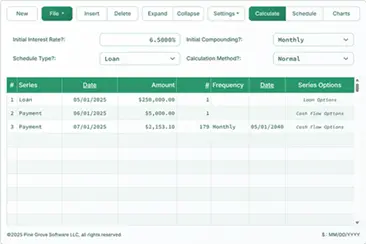How to Calculate a Loan with a Stub First Period
To set your preferred currency and date format, click the “$ : MM/DD/YYYY” link in the lower right corner of any calculator.
A Step-by-Step Tutorial
Tutorial 13
Most loans begin with an irregular or odd-length first period. Accountants refer to this as a “stub period.” This situation occurs when a borrower receives loan funds on one date, but the first scheduled payment is due on a different date. This tutorial explains the options for calculating interest during this initial period. Your choice affects the amount of each payment and the total interest paid over the life of the loan.
Example: In the United States, mortgage payments are usually due on the first day of each month. If a real estate loan closes on July 15 and the first payment is due on September 1, this creates an odd-length first period. Specifically, it is a “long first period”. As a result, additional interest is owed for the time from July 15 to August 1. This extra interest can be handled in one of three ways, which are explained later in this tutorial. If the loan closes on August 15 and the first payment is still due on September 1, the result is a “short first period”.
Important: It is essential to understand these options. Short and long stub periods affect interest calculations for all loans that do not have a regular-length first period. If the “Amortized” option is used, every payment amount will be slightly higher than expected. This is because part of the interest from the initial odd days is included in each payment.
We recommend reviewing the more detailed first tutorial to learn about the basic concepts and settings used in the UFC.
To create an amortization schedule that includes an odd-length first period, follow these steps:
- Set Schedule Type to Loan.
- Alternatively, click to clear any previous entries.
- Click , then select . Set “Rounding” to Open balance — no adjustment.
- In the header section, apply the following settings:
- Select Normal for Calculation Method.
- Set Initial Compounding to Daily.
- Enter 6.5 as the Initial Interest Rate.
- In row 1 of the cash-flow input area, create a “Loan” series.
- Set the “Date” to July 15, 2024.
- Set the “Amount” to 425,000.00.
- Set “# Periods” to 1.
- Note: Because the number of periods is 1, you will not be able to set a frequency. If a frequency is selected, it will be cleared when you leave the row.
- Move to row 2 of the cash-flow input area. At this point, the regular payment amount is unknown.
- Select “Payment” for the “Series”.
- Set the “Date” to September 1, 2024.
- Set the “Amount” to “Unknown”.
- Set “# Periods” to 360.
- Before you click , your screen should look like this (Fig. 1):

(Relative to the scheduled “Monthly” payment frequency.)
- The Ultimate Financial Calculator has four options for calculating interest during a long initial period (also known as “odd-days interest”). In this example, odd-day interest is the interest due to the lender from July 15 to August 1. These options are described below…
- Click , then select . This opens the “Initial Period Interest Payment Options” window.
- There are four available methods:
- “None” — Ignore odd-day interest. (This option is rarely used in practice.)
- “With origination” — Collect odd-day interest (also called “prepaid interest” under the Truth-in-Lending Act) on the loan origination date: July 15 in this example. See Fig. 2.
- “With first” — Include the interest with the first payment.
- “Amortized” — Spread the interest evenly across all payments. This increases each payment slightly.
- There are four available methods:

- Select “With origination”.
- Click .
- The result is $2,686.29 if the odd-day interest is collected on the loan date (or with the first payment). See Fig. 3.

- The result is $2,694.53 when the odd‑day interest is amortized (added evenly to each payment). See Fig. 4.

- Check the amortization schedule by clicking :
- The $1,304.58 payment covers interest accrued from July 15 to August 1. See Fig. 5.

- There are three options for handling a short initial period:
- Because the first period is shorter than a regular payment period, there is no odd‑day interest to collect.
- A short first period results in less accrued interest. You can handle this in one of three ways:
- “No payment reduction” — Apply a larger portion of the first payment to principal. This reduces total interest over the loan term.
- “Reduce first” — Lower the first payment only. All other payments remain unchanged.
- “Reduce all” — Reduce every payment slightly from the original amount.
Lenders may use different methods to calculate interest for an irregular initial period. Regardless of the method chosen, the Ultimate Financial Calculator allows you to audit the result easily.
Back to the Ultimate Financial Calculator.
